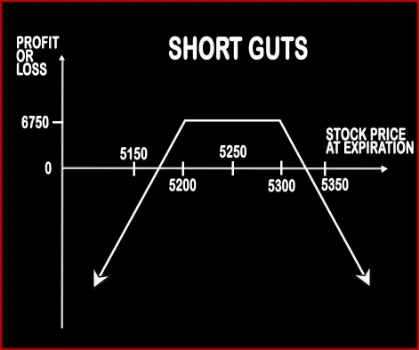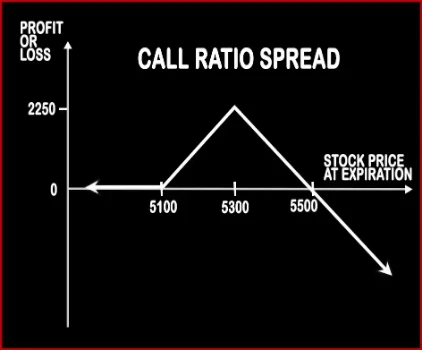Compare Strategies
| SHORT GUTS | RATIO CALL SPREAD | |
|---|---|---|

|

|
|
| About Strategy |
Short Guts Option StrategyThis strategy is implemented by a trader when he is neutral on the movements and bearish on volatility i.e. he expects the stock to be range bound in the near future. This strategy involves sale of 1 ITM Call Option and 1 ITM Put Option. This strategy can be called as Credit Spread since his account is credited at the time of entering in the positions. |
Ratio Call Spread Option StrategyAs the name suggests, a ratio of 2:1 is followed i.e. buy 1 ITM Call and simultaneously sell OTM Calls double the number of ITM Calls (In this case 2). This strategy is used by trader who is neutral on the market and bearish on the volatility in the near future. Here profits will be capped up to the premium amount and risk will be potentially unlimited since he is .. |
SHORT GUTS Vs RATIO CALL SPREAD - Details
| SHORT GUTS | RATIO CALL SPREAD | |
|---|---|---|
| Market View | Neutral | Neutral |
| Type (CE/PE) | CE (Call Option) + PE (Put Option) | CE (Call Option) |
| Number Of Positions | 2 | 3 |
| Strategy Level | Beginners | Beginners |
| Reward Profile | Limited | Limited |
| Risk Profile | Unlimited | Unlimited |
| Breakeven Point | Upper Breakeven Point = Net Premium Received + Strike Price of Short Call, Lower Breakeven Point = Strike Price of Short Put - Net Premium Received | Upper Breakeven Point = Strike Price of Short Calls + (Points of Maximum Profit / Number of Uncovered Calls), Lower Breakeven Point = Strike Price of Long Call +/- Net Premium Paid or Received |
SHORT GUTS Vs RATIO CALL SPREAD - When & How to use ?
| SHORT GUTS | RATIO CALL SPREAD | |
|---|---|---|
| Market View | Neutral | Neutral |
| When to use? | This strategy is implemented by a trader when he is neutral on the movements and bearish on volatility i.e. he expects the stock to be range bound in the near future. | This strategy is used by trader who is neutral on the market and bearish on the volatility in the near future. Here profits will be capped up to the premium amount and risk will be potentially unlimited since he is selling two calls. |
| Action | Sell 1 ITM Call, Sell 1 ITM Put | Buy 1 ITM Call, Sell 2 OTM Calls |
| Breakeven Point | Upper Breakeven Point = Net Premium Received + Strike Price of Short Call, Lower Breakeven Point = Strike Price of Short Put - Net Premium Received | Upper Breakeven Point = Strike Price of Short Calls + (Points of Maximum Profit / Number of Uncovered Calls), Lower Breakeven Point = Strike Price of Long Call +/- Net Premium Paid or Received |
SHORT GUTS Vs RATIO CALL SPREAD - Risk & Reward
| SHORT GUTS | RATIO CALL SPREAD | |
|---|---|---|
| Maximum Profit Scenario | Net Premium Received + Strike Price of Short Put - Strike Price of Short Call - Commissions Paid | Strike Price of Short Call - Strike Price of Long Call + Net Premium Received - Commissions Paid |
| Maximum Loss Scenario | Price of Underlying - Strike Price of Short Call - Net Premium Received OR Strike Price of Short Put - Price of Underlying - Net Premium Received + Commissions Paid | Price of Underlying - Strike Price of Short Calls - Max Profit + Commissions Paid |
| Risk | Unlimited | Unlimited |
| Reward | Limited | Limited |
SHORT GUTS Vs RATIO CALL SPREAD - Strategy Pros & Cons
| SHORT GUTS | RATIO CALL SPREAD | |
|---|---|---|
| Similar Strategies | Short Strangle (Sell Strangle), Short Straddle (Sell Straddle) | Variable Ratio Write |
| Disadvantage | • Unlimited potential loss if the underlying stock continues to move in one direction. • High margin required. | • Unlimited potential loss. • Complex strategy with limited profit. |
| Advantages | • Ability to profit even when underlying asset stays stagnant. • You are already paid your full profit the moment the position is put on as this is a credit spread position. • Higher chance of ending in full profit as compared to short strangle or short straddle. | • Downside risk is almost zero. • Investors can book profit from share prices moving within given limits. • Trader can maximise profit when the share closes at the upper breakeven point. |